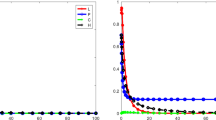Summary
The interaction of three species of terrestrial slugs was studied in six field cages containing monocultures and 2-way combinations.A. columbianus andA. ater were non-aggressive species andL. maximus was highly aggressive during the summer. All three species were similar in body design and resource utilization. Reproduction (egg size, eggs/batch, number of batches, wet-weight productivity) and mortality were monitored through the 1977 season.L. maximus drastically reduced reproductive success of the non-aggressive slugs and increased their mortality. There were also significant interactions between the non-aggressive species.
Compared to other invertebrates, the life history characteristics ofA. columbianus are stronglyK-selected and probably evolved through intraspecific exploitative competition in predictable, stable forest habitats.A. ater is best classified as a refugingr-selected species adapted to less predictable, unstable field environments.L. maximus appears to be α-selected and its overall design is suited to density-dependent regulation in fields.
Similar content being viewed by others
References
Bailey, S. E. R. (1981) Circannual and circadian rhythms in the snailHelix aspersaMüller and the photoperiodic control of annual activity and reproduction.J. Comp. Physiol. (A)142: 89–94.
Carrick, R. (1938) The life history and development ofAgriolimax agrestis L., the grey field slug.Trans. Roy. Soc. Edin.59: 563–597.
Cates, R. G. andG. H. Orians (1975) Successional status and the palatability of plants to generalized herbivores.Ecology56: 410–418.
Denny, M. (1980) Locomotion: the cost of gastropod crawling.Science208: 1288–1290.
Doucette, C. F. (1954) An introduced slug,Arion ater (L.) and its control with metaldehyde.J. Econ. Entomol.47: 370.
Frömming, E. (1954)Biologie der mitteleuropäischen Landgastropoden. Duncker and Humblot, Berlin.
Geiger, R. (1965)The climate near the ground. Harvard Univ. Press.
Gill, D. E. (1974) Intrinsic rate of increase, saturation density, and competitive ability. II. The evolution of competitive ability.Amer. Natur.108: 103–116.
Hamilton, P. A. (1981)The effects of food and slug density on slug movement. M. Sc. Thesis, Univ. of British Columbia.
Krebs, C. J. (1978)Ecology: The experimental analysis of distribution and abundance. 2nd Ed. Harper and Row Publ.
Künkel, K. (1916) Zür biologie der Lungenschnecken.Heidelberg Akad. Wissenschl.16: 440 pp.
Luchtel, D. (1972) Gonadal development and sex determination in pulmonate molluscs II.Arion ater rufus andDeroceras reticulatum.Z. Zellforsch.130: 302–311.
McGrone, E. J. andP. G. Sokolove (1979) Brain-gonad axis and photoperiodically stimulated sexual maturation in the slug,Limax maximus.J. Comp. Physiol. (A)133: 117–123.
Ovington, J. D. (1965)Woodlands. English Univ. Press, Lond.
Pianka, E. R. (1970) Onr- andK-selection.Amer. Natur.104: 592–597.
Pianka, E. R. (1978)Evolutionary ecology. 2nd Ed. Harper and Row Publ.
Pilsbry, H. A. (1948) Land Mollusca of North America (north of Mexico).Philadelphia Acad. Nat. Sci. Mono.3: 573 pp.
Pollard, E. (1975) Aspects of the ecology ofHelix pomatia L.J. Anim. Ecol.44: 305–339.
Richter, K. O. (1976)The foraging ecology of the banana slug Ariolimax columbianus Gould (Arionidae). Ph. D. Thesis, Univ. Washington.
Rising, T. L. andK. B. Armitage (1969) Acclimation to temperature by the terrestrial gastropods,Limax maximus andPhilomycus carolinianus: oxygen consumption and temperature preference.Comp. Bioch. Physiol.30: 1091–1114.
Rollo, C. D. (1974)Ecology of the slugs Deroceras reticulatum, D. laeve, and Arion fasciatus in Ontario corn fields. M. Sc. Thesis, Univ. of Guelph.
Rollo, C. D. (1978)The behavioural ecology of terrestrial slugs. Ph. D. Thesis, Univ. British Columbia.
Rollo, C. D. (1983) Consequences of competition on the time budgets, growth and distributions of three species of terrestrial slugs.Res. Popul. Ecol.25: 44–68.
Rollo, C. D. andW. G. Wellington (1975) Terrestrial slugs in the vicinity of Vancouver, British Columbia.Nautilus89: 107–115.
Rollo, C. D. andW. G. Wellington (1977) Why slugs squabble.Nat. Hist.86: 46–51.
Rollo, C. D. andW. G. Wellington (1979) Intra- and inter-specific agonistic behaviour among terrestrial slugs (Pulmonata: Stylommatophora).Can. J. Zool.57: 846–855.
Rollo, C. D. andW. G. Wellington (1981) Environmental orientation by terrestrial Mollusca with particular reference to homing behaviour.Can. J. Zool.59: 225–239.
Runham, N. W. andP. J. Hunter (1970)Terrestrial slugs. Hutchinson and Co. Publ., Lond.
Smith, B. J. (1966) Maturation of the reproductive tract ofArion ater (Pulmonata: Arionidae).Malacologia4: 325–349.
Sokolove, P. G. andE. J. McCrone (1978) Reproductive maturation in the slugLimax maximus and effects of artificial photoperiod.J. Comp. Physiol. (A)125: 317–325.
Stearns, S. C. (1977) The evolution of life history traits: a critique of the theory and a review of the data.Ann. Rev. Ecol. Syst.8: 145–171.
Wellington, W. G. (1965) Some maternal influences on progeny quality in the western tent caterpillarMalacosoma pluviale (Dyar).Can. Entomol.97: 1–14.
Williamson, P., R. A. D. Cameron andM. A. Carter (1977) Population dynamics of the landsnailCepaea nemoralis L.: a six-year study.J. Anim. Ecol.46: 181–194.
Author information
Authors and Affiliations
Rights and permissions
About this article
Cite this article
Rollo, C.D. Consequences of competition on the reproduction and mortality of three species of terrestrial slugs. Res Popul Ecol 25, 20–43 (1983). https://doi.org/10.1007/BF02528782
Issue Date:
DOI: https://doi.org/10.1007/BF02528782




